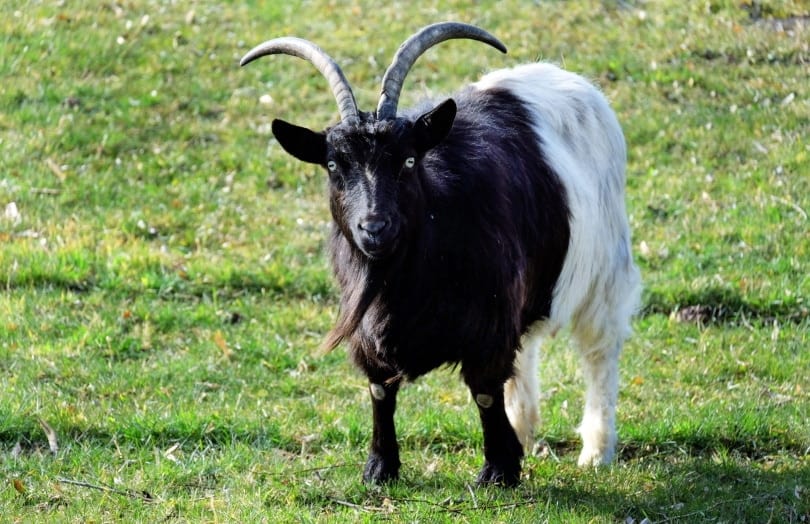We humans look into each other’s eyes to determine a range of emotions and communications. Looking into the eyes of a goat is a strange experience. Their rectangle pupils seem to look straight through you, and you may be wondering just what they are seeing and perceiving around them.
Contrary to popular belief, goats are not colorblind! Goats are dichromatic and have two color-receptor cones that allow them to see color. They can perceive the difference between a wide range of tones and colors. Colorvision helps them to spot and evade predators and to forage for safe foods.
But the perception of color isn’t as simple as we make it out it be. In fact, we cannot perceive as many colors like some other animals! Color is a spectrum and how it is received depends on the biology of each animal’s eye. Let’s delve in to learn more about the iconic goat eye and the colors it sees.

How Do Animals Perceive Color?
The perception of color is not as simple as do or do not! Color is distinguished in the animal eye by cones (whereas rods perceive light levels). Most animals are known as either monochromatic, dichromatic, or trichromatic. This means they have respectively one, two, or three cone receptors in their eyes.
An animal that lacks cones altogether will not be able to see any colors at all. The only known animal without any photoreceptor cones are skates, a fish related to sharks and rays.
Other animals we would consider colorblind include animals who are “monochromats,” which means they possess just one type of cone, so they will see the world in tones of black and whites. These are primarily marine animals such as sharks, whales, and dolphins, as color vision is not helpful in an aquatic environment.
The animal with the most cone receptors is the mantis shrimp; this little guy has a whooping 16 color cone. Just imagine the psychedelic world they see around them.

What Colors Can Goats See?
Goats are dichromatic, so they have two cones in their eyes. One picks up on blue light, and the other picks up on green light. They lack the cone that is sensitive to the different tones of red. So, while they can see greens and blues just fine, they struggle to see the difference between greens and reds. These colors will not be able to be perceived differently, rather seen as a continuous yellowish shade.
While red colors may appear to be differently shaded than greens and blues, they will not differentiate between shades of red due to the lack of the red-light cone.
From their color spectrum, they are best at seeing orange and worst at seeing blue. This is evolutionary as the orange will stick out from a sea of green like a sore thumb, allowing them to spot the contrasting colors of a predator approaching.
Goat vs. Human Color Vision
While goats are dichromatic, humans are trichromatic. This means we possess one more color cone than goats, and this cone is the red-light cone. This makes our range of colors and tones (particularly reds) vaster than a goat.
While goats are not considered truly colorblind in science, by human standards, they kind of are! If a person could not perceive reds from greens, they would be regarded as red-green colorblind. This kind of colorblindness is the most common in humans and doesn’t affect the average person’s life very much.

The 4 Goat Vision Evolutionary Advantages
1. Color Vision
As mentioned, the perception of color is a survival advantage for goats. They will be able to perceive other animals of contrasting colors to their surroundings and react appropriately. This color vision will also help to identify forage that is safe for them to eat.
2. Rectangle Pupils
We couldn’t discuss goats’ vision without mentioning the freaky shape of their pupils! They possess very distinct rectangle-shaped pupils. This allows them to see from 320-340 degrees around them, with only a tiny 20-degree blind spot. This helps to look out for predators and dangers while foraging in wide open areas so that they can quickly respond.
3. Binocular Vision
In addition to an expansive vision, goats have excellent depth perception. This is helpful for them as they jump and climb over steep and challenging terrain.
4. Nightvision
Goats’ pupils can control the amount of light that enters them. This helps them to see just fine in the dark so they can navigate their way around. While this vision is not as good as their day vision it is helpful for them to get around and identify movements.


Final Thoughts
The perception of color is by no means a linear thing! While if one of us had the vision of a goat, we might be considered colorblind by human standards, for goats, this perception of color is normal. Although there are some colors and tones that they struggle to differentiate, goats can see a very reasonable range of colors, which assists them in their wild survival.
You Also Be Interested In:
Featured Image Credit: Piqsels
